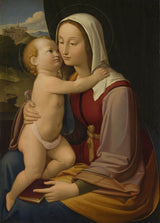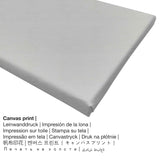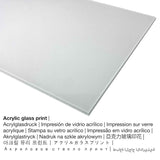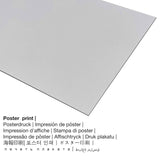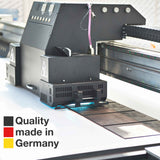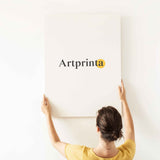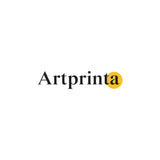Johann Friedrich Overbeck, 1818 - Nwa agbọghọ na-amaghị nwoke na nwa - mbipụta nka mara mma
Ụtụ gụnyere. Mbupu gbakọrọ na ndenye ọpụpụ.
Akụkụ nke art"The Virgin na Nwa" painted by Johann Friedrich Overbeck as your new art copy
"The Virgin and Child" is a painting created by Johann Friedrich Overbeck in 1818. The more than 200 Afọ mbụ ka e jiri nha ndị a mee: 65,8 x 47,1 cm e were kwa ihe-ọcha tee ya mmanụ n'elu osisi. Agụnyere ihe osise a na Ụlọ ihe ngosi nka nke Thorvaldsens nchịkọta nka dijitalụ na Copenhagen, Denmark. Site n'ikike nke: Johann Friedrich Overbeck, The Virgin and Child, 1818, Thorvaldsens Museum, www.thorvaldsensmuseum.dk (ikike - ngalaba ọha).Additionally, the work of art has the creditline: . What is more, the alignment is portrait with a side ratio of 1: 1.4, nke pụtara na ogologo bụ 29% mkpụmkpụ karịa obosara.
Kedu ụdị ihe kacha amasị gị?
We offer a range of various materials and sizes for every product. You can pick your preferred material and size among the following options:
- Aluminom dibond mbipụta (ọla): Aluminium Dibond prints are prints on metal with a true depth effect - for a modern look and a non-reflective surface. For the Aluminium Dibond option, we print your selected artwork on the aluminium white-primed surface. The colors are luminous in the highest definition, details of the print are very clear. The direct print on aluminium is the most popular entry-level product and is an extremely contemporary way to showcase fine art reproductions, because it draws attention on the artwork.
- Mbipụta akwụkwọ mmado (ihe kwaaji): A poster print is a UV printed canvas paper with a fine surface structure, which resembles the original artwork. It is ideally qualified for framing your art print using a custom frame. Please bear in mind, that depending on the absolute size of the poster print we add a white margin of around 2-6cm around the print, which facilitates the framing.
- Kwaaji: The canvas direct print is a printed cotton canvas stretched on a wood stretcher. The great advantage of canvas prints is that they are relatively low in weight, which implies that it is easy to hang your Canvas print without any wall-mounts. Canvas prints are suitable for all types of walls.
- Ihe odide acrylic glass: The acrylic glass print, often described as a print on plexiglass, will change your favorite original into marvellous home decoration. Your favorite work of art is made with state-of-the-art UV printing machines. It makes vibrant, stunning color tones. The great benefit of an acrylic glass art print is that contrasts and also minor details will be visible thanks to the delicate gradation in the picture.
Ederede iwu: We try the best we can in order to describe the products as accurate as possible and to display them visually in our shop. Please bear in mind that the tone of the print materials and the imprint might vary somehwat from the image on your device's monitor. Depending on the settings of your screen and the condition of the surface, colors can unfortunately not be printed one hundret percent realistically. In view of the fact that our fine art prints are processed and printed by hand, there might as well be minor discrepancies in the motif's exact position and the size.
Banyere ihe a
| Bipụta ụdị ngwaahịa: | ọrụ mgbidi |
| Usoro mmeputakwa: | dijitalụ mmeputakwa |
| Usoro mmepụta: | mbipụta dijitalụ |
| Production: | emere na Germany |
| Stockdị ngwaahịa: | na mmepụta ihe |
| Eji ngwaahịa a chọrọ: | mgbidi gallery, mgbidi mgbidi |
| Nhazi nka nka: | usoro eserese |
| Ụdị anya: | 1: 1.4 |
| Pụtara nha akụkụ onyonyo: | ogologo bụ 29% mkpụmkpụ karịa obosara |
| Akwa mmeputakwa dị: | Mbipụta kwaaji, mbipụta ọla (aluminium dibond), mbipụta akwụkwọ mmado (akwụkwọ kwaaji), mbipụta enyo acrylic (nwere ezigbo mkpuchi iko) |
| Mbipụta kanvas (akwa akwa na etiti ihe ndọtị): | 50x70cm - 20x28", 100x140cm - 39x55" |
| Acrylic glass print (nwere ezigbo mkpuchi iko) nhọrọ: | 50x70cm - 20x28", 100x140cm - 39x55" |
| Nhọrọ nha nke akwụkwọ mmado (akwụkwọ kwaaji): | 50x70cm - 20x28" |
| Nha ebipụta aluminium dibond: | 50x70cm - 20x28", 100x140cm - 39x55" |
| Nhazi mbipụta nka: | adịghị |
Ozi ndabere gbasara ọrụ nka mbụ
| Aha nka: | "The Virgin na Nwa" |
| Nhazi nka: | sere |
| Okwu nche anwụ: | nkà nke oge a |
| Time: | 19th narị afọ |
| Emepụtara n'afọ: | 1818 |
| Ogologo afọ nka nka: | karịa afọ 200 |
| Usoro nka izizi: | mmanụ n'elu osisi |
| Akụkụ nke ọrụ nka mbụ: | 65,8 x 47,1 cm |
| Ụlọ ihe ngosi nka: | Ụlọ ihe ngosi nka Thorvaldsens |
| Ebe ebe ngosi nka: | Copenhagen, Denmark |
| Weebụsaịtị ihe ngosi nka: | Ụlọ ihe ngosi nka Thorvaldsens |
| Ụdị nka nka: | ngalaba ọha |
| Site n'aka: | Johann Friedrich Overbeck, The Virgin and Child, 1818, Thorvaldsens Museum, www.thorvaldsensmuseum.dk |
Nkọwa onye nka
| Ihe nkiri: | Johann Friedrich Overbeck |
| Aha ndị ọzọ: | Overbeck Johann Friedrich, Overbeck Joh. Friedrich, overbeck fr., Johann Friedrich Overbeck, Joh. Friedrich Overbeck, fritz overbeck, Overbeck J. Fr., fr. overbeck, Overbeck Friedrich, Overbeck F., Friedrich Overbeck, Overbeck, Joh. Fr. Overbeck, Overbeck J. F., overbeck fritz |
| okike nke onye nka: | nwoke |
| Obodo onye nka: | German |
| Ọrụ nke onye na-ese ihe: | illustrator, painter, poet, writer |
| Country: | Germany |
| Otu nka: | omenkà nke oge a |
| Nwụrụ anwụ: | 80 afọ |
| A mụrụ: | 1789 |
| Amụrụ na (ebe): | Lubeck, Schleswig-Holstein, Germany |
| Afọ ọnwụ: | 1869 |
| Nwuru na (ebe): | Rome, Rome Province, Lazio, Italy |
Copyright right, www.artprinta.com (Artprinta)
What does the curator team of the Thorvaldsens Museum write about this work of art created by Johann Friedrich Overbeck? (© Nwebiisinka - Thorvaldsens Museum - Ụlọ ihe ngosi nka Thorvaldsens)
The Madonna is impersonal, totally lacking sensuality, delicate as porcelain and expressive precisely of the piety to which Overbeck dedicated his life and for which he strove in his art. The child is looking at his mother, while she for her part is staring straight ahead. Her finger in the book shows where she has her thoughts. She is thinking of the suffering and death that await the Son of Man, but she is not weighed down, for she also knows the continuation of the story. In the background, Overbeck has painted a path leading up the mountain. At the top, the mountain is surmounted by a town characterised by a mysterious ship-like building. It may be that this strange building in Overbeck’s painting is intended to remind us of the Ark, which naturally has come to stand as a symbol of redemption and eternal life. In other words, Mary foresees not only the death of Christ, but also His resurrection. Overbeck, who derived from Protestant North German, converted to Catholicism in 1813 and spent the rest of his life in Rome. He is considered the most important member of the group of artists who came to Rome in 1810 and became known as the Nazarenes because they dressed in long robes, painted religious motifs and let their hair grow like that of Jesus of Nazareth. They modelled themselves on the artists of the High Renaissance such as Michelangelo, Titian and especially Raphael. Thorvaldsen and Overbeck knew and respected each other. In 1814, perhaps in order to give Overbeck financial support, Thorvaldsen commissioned a series of drawings based on his Alexander Frieze, which were to serve as patterns for prints in a book, and at a later date there was also talk of the two working together in connection with the design of the Gutenberg monument in the city of Mainz.

